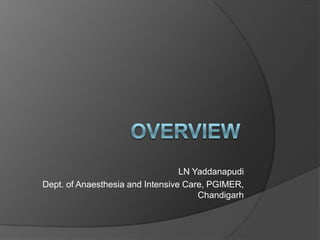
Guide to Research Process and Study Designs
- 1. LN Yaddanapudi Dept. of Anaesthesia and Intensive Care, PGIMER, Chandigarh
- 2. How to conduct a clinical trial Research question Study designs CONSORT step-by-step Sample size and power calculations Randomization and blinding Data processing Simple-minded guide to hypothesis testing
- 4. Research Process Research question Background of the research Study design Study population Study variables Data Collection Quality control Statistical analysis Dissemination of data
- 5. Good research depends on a clear question understanding the context of the question being able to use appropriate methods to answer the question knowing when to stop
- 6. Starting points Discussion with a supervisor or colleagues, email, discussion groups, mailing lists Databases - Cochrane, NEXUS, Project Impact. "further research needed" sections of journal articles, papers, theses and dissertations in the subject area of your interest Topic definitions in encyclopaedias and "state-of-the-discipline" reviews in the journal literature
- 7. What are you looking for? topics where there is doubt and uncertainty disputed or contradicted statements topics where evidence is incomplete, lacking, dated topics where evidence from a study on one community or group could be compared with evidence from an associated group topics which interest you
- 8. Requirements Mastering the literature Being alert to new ideas and techniques Conferences Meet researchers Skeptical attitude New technologies Imagination Observation Teaching Creativity Tenacity Choosing a mentor
- 9. Good research question Feasible No. of Subjects Technical expertise Affordable in time and money Manageable in scope Interesting Novel Confirms, refutes or extends previous findings New findings Ethical Relevant Scientific knowledge Clinical and health policy Future research
- 11. Descriptive studies Case reports Case series Population studies
- 12. Descriptive studies: Uses Hypothesis generating Suggesting associations
- 13. Analytical Studies Observational Cross-sectional Case-control Cohort Experimental
- 14. Cross-sectional studies Characteristics Data collected at single point of time Describes associations Prevalence Strengths Quick Cheap Weaknesses Can’t establish cause-effect
- 15. Case-Control Study Start with people who have disease Match them with controls that do not Look back and assess exposures
- 16. Case-Control Study: Strengths Good for rare outcmes Can examine many exposures Useful to generate hypotheses Fast Cheap Provides Odds Ratio
- 17. Case-Control Study: Weaknesses Cannot measure Incidence Prevalence Relative Risk Can only study one outcome High susceptibility to bias
- 18. Cohort Study Begin with disease-free patients Classify patients as exposed/unexposed Record outcomes in both groups Compare outcomes using relative risk
- 19. Cohort Study: Strengths Provides incidence data Establishes time sequence for causality Eliminates recall bias Allows for accurate measurement of exposure variables Can measure multiple outcomes Can adjust for confounding variables Can calculate relative risk
- 20. Cohort Study: Weaknesses Expensive Time consuming Cannot study rare outcomes Confounding variables Exposure may change over time Disease may have a long pre-clinical phase Attrition of study population
- 21. Clinical Trials Randomized Double-blind Placebo-controlled
- 22. Randomized Controlled Trial Outcome Treatment Group Randomization No Outcome Study Population Outcome Control Group No Outcome
- 23. Clinical Trials Strengths: Best measure of causal relationship Best design for controlling bias Can measure multiple outcomes Weaknesses: High cost Ethical issues may be a problem Compliance
- 25. Clinical decisions Patient’s circumstances Evidence and wishes Clinical Audit Technology assessment Strategies to Practice Economic Systematic Primary implement guidelines studies reviews studies guidelines
